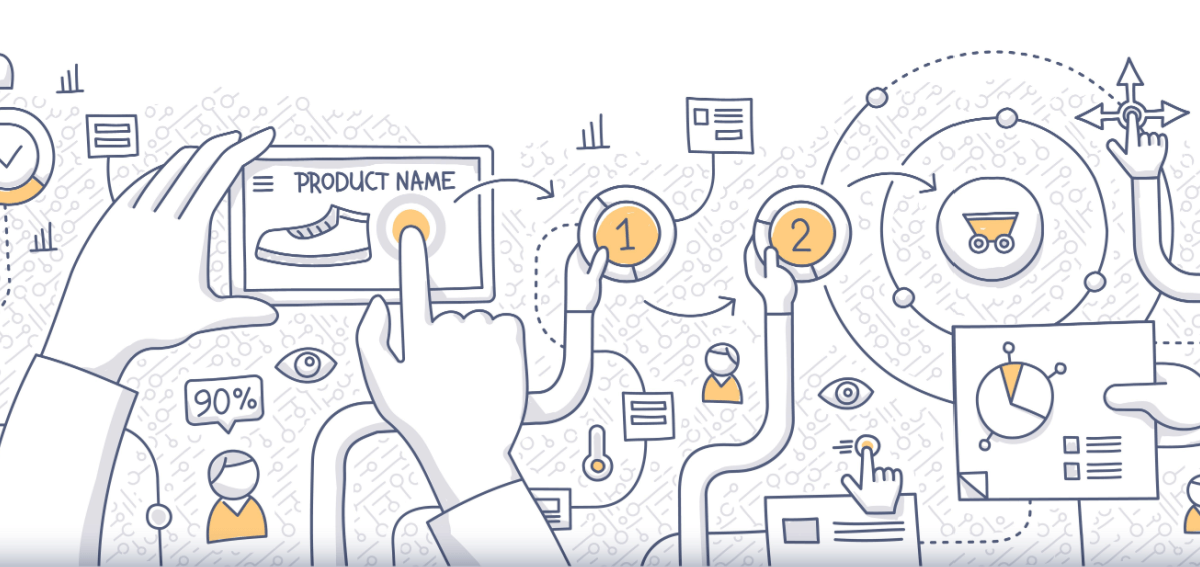Table of Contents
What’s the connection between user experience and technical support companies? You know that keeping users satisfied and creating an outstanding user experience (UX) helps ensure loyalty and sales. But how does tech support interface with UX? This basic guide offers you what you need to know about (UX) and technical support and how they’re related.
Let’s dive in to find the details. And make sure you keep reading to discover how outsourced technical support improves UX.
What Is User Experience?

UX is the general experience of an individual or a consumer using a product or service. That includes a software application, a website, hardware, a smartphone, or a gadget. UX reveals how convenient, pleasing, difficult, or poorly a person uses or finds the product or service.
UX Market to Explode
The global UX market by 2028 might hit almost $1.4 billion, up from $465 million in 2021, at a compound annual growth rate (CAGR) of around 16% within the seven-year projected period.
The expected continued rise indicates that more industries and companies recognize UX’s key role in overall growth, efficiency, and customer service. For the past several years, established companies have been purchasing UX platforms. The demand for UX professionals has driven salaries to a higher level.
Why Does a Business Need UX?
Below are five reasons you need UX.
- Higher return on investment (ROI). Investing in a solid UX strategy improves ROI. A better experience means users buy more and endorse your products or service to others.
- More positive feedback. Providing pleasurable experiences to users builds and maintains their brand loyalty. The chance they’ll switch products or services diminishes. Customer retention is less costly than acquiring new ones.
- Enhanced brand image. Focusing on UX enables the products or services to stand out. It differentiates them from competitors, giving you a business edge and the opportunity to corner a larger share of the market.
- Reduced operating expenses. Better UX translates to lower costs. Companies do not need to spend much convincing existing and satisfied users to buy, hiring more employees to handle customer issues, and ensuring fewer bugs, patches, and other technical issues.
- Better insight. UX enables the gathering of user preferences and other relevant information. This data helps you improve the product or service for a more meaningful experience.
What Makes UX Different From Customer Experience (CX)?
UX is about the end user, while CX focuses on the customer, who is not necessarily a product user.
For instance, a purchasing manager buys laptops for employees. The manager is the customer, while the staff is the end user. For the seller to get the deal, it must provide a great CX, from marketing and answering questions and concerns to negotiating and delivery. An excellent UX, on the other hand, is achieved when the workers enjoy using the devices.
The following are the other differences between the two.
| UX | CX |
| Technical and design in nature | Marketing in nature |
| Usability-focused | Brand- and revenue-focused |
| Covers mainly digital products | Caters mostly to industries |
| Helps users complete the tasks | Helps consumers have a good experience |
| Develops specifications/prototypes | Conducts market research |
What Are the Components of UX?
Measuring UX has no standard approach and varies in every company. It all comes down to how pleased users are and the probability of telling others about their gratifying encounters. Here are some key performance indicators (KPIs), or quantitative metrics, to measure UX.
- Customer satisfaction (CSAT) score. The KPI gauges how satisfied a user is with the product, service, or feature. Customers typically receive surveys by email. They scale their satisfaction level (from “highly dissatisfied” to “highly satisfied”) or answer “yes” or “no” to a binary question.
- Time-on-task. The metrics estimate a user’s efficiency or productivity when using the product or service. Spending a lot of time hints that a design, feature, or function is not user-friendly. An example is how long it takes for a customer to find and use the self-service option on the company website to receive additional information.
- Churn rate. The portion of current customers who stop doing business is called the churn rate, and is when customers no longer buy or subscribe. Ideally, a company’s churn rate is less than its growth rate or the number of new buyers.
- Adoption rate. This rate pertains to the share of users applying a new feature or function of a product or service. For instance, you have released the latest add-on to a software application, and 20 of the 100 existing customers use it. The adoption rate is 20%.
- Net promoter score (NPS). The benchmark measures user satisfaction by sending a survey asking the user to grade how likely they are to recommend a product or service to a friend. Developed by American author Fred Reichheld, NPS groups respondents based on their scores: 0 to 6 are detractors, 7 to 8 are passives, and 9 to 10 are promoters.
- Website speed. Also known as page speed or page load, it means how fast your website shows content to users. The accepted speed load is less than 400 milliseconds faster than the blink of an eye. Websites with lower speeds are at a disadvantage.
What Is a Technical Support Company?

A technical support company is a third-party vendor offering customer or user support related to the use of a product or service. It is also known as an outsourced information technology (IT) provider, a business process outsourcing (BPO) company, or an external service provider.
A BPO firm consists of a technical support team (also called an IT or help desk team) assisting users in resolving their questions and issues about product or service use.
Outsourced tech support is a back-office outsourcing service used by many organizations to improve workflow efficiency and reduce operating expenses. The business strategy can help a company compete with other industry players targeting the same market.
A help desk team is in charge of other user-centered tasks, including troubleshooting hardware and software problems, configuring computer networks, conducting system safety checks, and installing new applications or antivirus programs.
Technical Support Companies Are Here to Stay
According to a report from Research and Markets, the global IT services market will continue to grow by 2026. The industry’s value is roughly $1.1 trillion, increasing at a CAGR of around 8% within the five-year forecast period.
The report attributes the rising demand for IT services to the increased adoption of cloud-driven platforms and the automation of business processes. In particular, the cloud-based IT service sector has seen accelerated growth in small and medium enterprises (SMEs) for several years. By 2026, the SME segment might corner over 80% of the market share.
The demand for information security management platforms and IT service management is expanding. The increasing use of advanced technologies (e.g., the internet of things) across enterprises drives this uptrend.
North America (U.S. and Canada) grabs the lion’s share of the IT services market. More companies opt for cloud-based solutions. They are more affordable and efficient than on-premises tools.
Why Do Businesses Need a Technical Support Company?
Here are eight common reasons companies contract with a technical support company:
- Reduced in-house work volume. Getting the services of a BPO company prevents high recruitment costs, including sourcing, interviews, examinations, onboarding, and training. The provider takes care of all these processes for you. Lower enlistment expenses also save you money.
- Different communication channels. A BPO firm’s tech support team uses various communication platforms for wider user accessibility. It offers email, live chat, phone calls, social media, self-service portals, and online communities. A diverse system allows seamless interaction with customers wherever they are and whatever devices they use.
- Proficient agents. A service provider supplies you with trained, responsive, and adaptable specialists when you outsource data entry services, tech support, and other back-end functions. They quickly adjust to situations when it comes to tasks and customer or user requirements.
- Multilingual support. Not all third-party vendors offer this service since talent is expensive and hard to find. Agents speaking fluent English and another market-relevant language are valued. They can reach out to more product or service users who prefer to speak in their mother tongue. Multilanguage tech service increases revenue potential.
- Advanced technologies. Many BPO organizations are heavy users of new technologies. They use good platforms and applications to improve back-office outsourcing services for better service and performance. As such, they enjoy seamlessness and high accuracy.
- 24/7 IT support. Service providers offer day-and-night tech support, making it available to users anytime. Time zone differences are no longer an issue. If customers can contact the team on holidays and weekends, the market base will likely increase, and sales will rise.
- Cost-effective, high-quality help desk service. A technical support company offers reasonable fees because it employs most IT professionals based in countries where low-cost, educated, and skilled workers abound. India, the Philippines, Ukraine, Mexico, and Brazil are well-known outsourcing destinations.
- Scalable tech support. Depending on the business condition, a BPO organization scales outsourced services, including data entry, IT, and customer service. It adjusts the number of staff without disrupting your operations, supplying more personnel during a boom and decreasing the numbers during a downturn.
What Are the Differences Between Technical Support and Customer Support?
Both tech support and customer support are types of customer service. They help consumers with their concerns, questions, problems, issues, and requests. Building and maintaining customer satisfaction and retention are the end goals of their daily operations.
Here are the main differences between the two processes.
Technical Support | Customer Support |
| Deals with hardware and software issues (laptops, desktops, consumer electronics, smartphones, operating systems, antivirus, and more) | Handles non-technical concerns and questions (new product or service inquiries, billing updates, company information, shipping and delivery, service complaints, and more) |
| Given to only those who requested this assistance | Provided to every touchpoint between a customer and business |
| Resolving technical issues promptly is the top priority | Delivering a smooth and friendly customer interaction is the primary goal |
| Requires more of a hard skill set and certifications (programming, troubleshooting, data engineering, web development, and more) | Put soft skills first such as communication skills, honesty, interpersonal and leadership skills, problem-solving skills, and similar traits |
How Does a Technical Support Company Enhance UX?

A BPO firm’s tech support team takes on the product and service details to help users maximize satisfaction. The IT group listens to their technical problems and guides them through every part they struggle with. It also teaches them the features and functions for better use.
Below are six ways a technical support company improves UX:
1. Manages Churn Rate
With its expertise and experience, the service provider determines a specific group of users who are likely to leave or abandon your product or service. An effective IT team channels its efforts and skills to the most profitable users on the verge of churning. You cannot convince everyone to stay, but the team retains the most valuable ones.
In addition, the IT help desk reduces, if not prevents, churn by frequently engaging with users about the product’s or service’s benefits. The team provides them with the importance of using it in their daily activities to ensure they will stay with you.
2. Improves CSAT
The tech support team responds quickly and even notifies users of the receipt of the tickets they have raised. This shows it values those who contact them for support. A prompt reply informs users that their concerns are already being assessed for review and answer. Quick response leads to a quick resolution that enhances customer satisfaction (CSAT).
Moreover, the IT team properly sends a survey after they resolve a ticket. They ask for feedback from users to obtain the right information without bothering them or wasting their time. The team conducts enough surveys to formulate a CSAT improvement plan.
3. Increases Adoption Rate
The tech support team increases the number of users adopting the new product, feature, or service by actively and positively interacting with them. The team walks users through from start to finish, easing them through the process to ensure they adopt it.
Furthermore, the help desk team uses advanced tools, such as product analytics, to process relevant data. It evaluates user behavior and journey, applying the information to enhance the product or service. Understanding user needs is vital to building a better brand for a higher adoption rate.
4. Boosts Website Speed
One of the responsibilities of an IT team is to maintain and update the website regularly. It ensures that the vital codes or upgrades are in place to optimize the site’s performance and functionality. The team monitors every web page, guaranteeing that the speed load is within the acceptable benchmark and downtime is always avoided or reduced.
The help desk also has web developers who minimize the codes and other elements to speed up page load time. Downloading and uploading take more time when web pages contain so many codes, whereas seamless browsing means improved UX.
5. Shortens Time on Task
The outsourced tech support team detects usability problems with the product or service. It spots the causes of a user’s long task completion time or failure to finish a particular activity on a website or an application interface. Based on its findings, the team reduces the time on task by using tools and user surveys.
Additionally, the IT help desk conducts usability tests to acquire honest and straight details from users. The method improves the product or service design suitable for your target market. Better usability translates to less time on task.
6. Maintains High NPS
BPO firms are constantly innovating their customer service (technical support and customer support) approach to deliver a sustainable, excellent consumer experience. One creative way to increase user satisfaction is through live chat. This communication channel offers a real-time reply to users. The quicker the response time, the more consumers can be reached.
Likewise, the tech support team makes users feel appreciated by asking for feedback whenever they deliver the service. It asks inviting questions that invite them to give as much feedback as they want. “How could your experience have been better?” is the common question the team sends to get their input.
Efficient Tech Support: The Key to Great UX

Whether you have already outsourced a help desk team or are still deciding to hire a technical support company, here are nine tips to improve tech support for better UX.
1. Review Existing Workflow
Evaluate the sequence of activities the IT team performs to finish a certain task. Look into each process, if possible. Identify the current and potential bottlenecks. Also, check for redundancies and tedious tasks that automation can handle. After finding out the workflow issues, develop solutions and consult with the team.
2. View Tech Support as a Revenue Driver
While IT support’s primary role is to help users with their product or service concerns, you must also treat it as vital for customer retention and brand loyalty. Allow team members to upsell and cross-sell to them. For instance, instruct the team to advise users on upgrades to avail of premium service.
3. Ensure the Right Tools Are Used
The IT help desk must have the proper tools and software to manage incoming calls, live chat, support tickets, self-service options, escalation, email, social media, and more. Tools are crucial to the team’s performance and efficiency. Check those that are no longer used frequently and declutter as needed. Better organization leads to faster service.
4. Make Help Desk Support More Accessible
When running a product or service-centered business, the technical support menu must be more visible on your website. Place the tech support link in a spot where users and visitors can quickly click on it. Convenience indicates that you are willing to serve them immediately. The tech support menu on the front page in the main navigation bar is ideal.
5. Ask for Input From Team Members
Acquiring feedback from tech support agents is an effective way to improve the current processes. Ask them about the problems and issues they face every day. Encourage each member to suggest how to enhance operations. Soliciting their comments is a sign that you value and appreciate them.
6. Monitor User Conversation Outside Your Channels
Assign a team member to track user conversation on social media, a forum, or a similar website. They typically post comments, reviews, or feedback about your company, products, or services. Make an effort to join in on the topic or a thread to answer their questions. Avoid promoting the company or product because many on the site find this improper.
7. Enhance Self-Service Support Options
The tech support team must develop and refine self-service support options to empower users. Accessible, knowledge-rich portals allow them to find solutions to basic issues without contacting the help desk. Some useful resources include an FAQ page, community forum, automated call center, AI-based messaging, and knowledge base content.
8. Apply Multi-tiered Tech Support
A well-structured IT team divided into at least three levels efficiently addresses different user requirements and technical issues with a product or service. The levels are:
- Tier 0: available to users to resolve issues by themselves with self-service support options
- Tier 1: addresses basic concerns, including installing and troubleshooting
- Tier 2: handles matters that tier 1 cannot solve
- Tier 3: deals with the most challenging user issues.
9. “Fix, Fix, Fix”
“Location, location, location” is a piece of popular real estate advice. The tech support corollary is “fix, fix, fix!” For tech support, it’s about fixing problems afflicting customers. All technical concerns, basic or complicated, are the same for many users: problems that have to be resolved ASAP.
Users reach out because they expect a quick response to address their issues. Fixing the issues immediately to satisfy them is always a significant contributor to UX.
The Bottom Line
A technical support company’s help desk team plays a crucial role in overall UX for product-centric companies. Businesses worldwide see the importance of UX in improving productivity, efficiency, and revenue. Such a view fuels the increasing demand for outsourced tech services.
When you outsource data entry, bookkeeping, and similar services, the BPO firm caters to a single client. With outsourced tech support, on the other hand, the service provider deals with numerous users with various issues.
That’s why hiring a technical support company with a competent team that provides excellent UX is critical.




